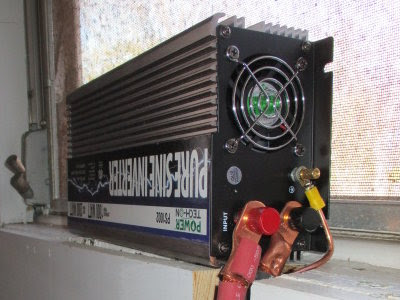Continued from Solar Project: Figuring Out the Wiring
 |
| Earth ground symbol |
Many solar setups tie all the components together and ground them as a unit. If we had been thinking several steps ahead we could have done that too. Because we were doing this one step at a time, Dan grounded the solar panels separately, as specified in their installation manual.
 |
| The grounding holes in the solar panels' aluminum frames are marked with the earth ground symbol. |
 |
| Lay-in lugs connect the neutral grounding wire to the panels. |
 |
| This photo makes it look like the wire loop on the right is touching itself. It's not! It's just the angle of the photograph. |
The grounding wire is connected to a grounding rod.
 |
| Alternatively, the ground wire could have run through the underground conduit (white pipe sticking out of the ground) to the battery box. |
At the battery bank box, the charge controller and inverter are grounded together. Each clearly shows where the ground wire attaches.
 |
| Charge controller innards. Ground wire on the right. |
 |
| Inverter ground wire on the right. |
The ground wires from the charge controller and inverter are connected in the battery box with a thingy called a busbar.
 |
| Busbar with two of the three ground wires attached. |
The third wire above (yet to be attached) will connect the busbar to the grounding rod. The ground wire from the panel array could have been connected here too. The busbar is a conductor and will direct wayward currents from either the controller or the inverter to the ground rod.
 |
| Our second ground rod near the battery bank box. |
That's a very important step accomplished!
Most of the cables are in place, but they aren't connected yet. There are a few more things to do first, and then we can put the system together.


7 comments:
Beware of copper thieves. There were countless similar setups at various small farms that dotted the countryside, mostly grounding the lightening rods on top of the buildings. But then copper prices got high and all that mysteriously disappeared from any abandoned farm. I've even seen them dig up the propane gas lines from the tank to the house as well.
I was wondering if you were going to ground your solar. LOL A DC shock is worse than an AC one. Says Jo who was once knocked across the room by DC and subsequently burned three fingers down to the bone by it. A faulty DC wire was the culprit and was living overseas at the time. It can literally stop your heart. I was lucky.
Ed, thieves are always a concern, aren't they? Hopefully, that won't happen.
Jo, wow, you were lucky. That's a very hard way to learn a lesson! I'm glad it wasn't worse.
Looks Good!
Man, it is a long time since I have seen that much copper.
TB, thanks! I have no idea why Dan went with copper. I know they sell them in steel, but he thinks the copper is better. So there you have it!
As strange as it sounds, our solar system in the modified boat/shed behind the float cabin grounds to the water. - Margy
Margy, interesting! Such a thing never occurred to me. But then, neither did living on water. ;) I'd be interested in what your set-up is like.
Post a Comment